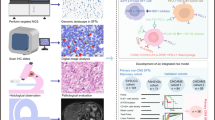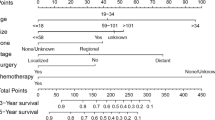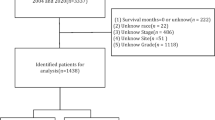Abstract
Background
Current risk models in solitary fibrous tumour (SFT) were developed using cohorts with short follow-up and cannot reliably identify low-risk patients. We recently developed a novel risk model (G-score) to account for both early and late recurrences. Here, we aimed to validate the G-score in a large international cohort with long-term follow-up.
Methods
Data were collected from nine sarcoma referral centres worldwide. Recurrence-free interval (RFi) was the primary endpoint.
Results
The cohort comprised 318 patients with localised extrameningeal SFTs. Disease recurrence occurred in 96 patients (33%). The estimated 5-year RFi rate was 72%, and the 10-year RFi rate was 52%. G-score precisely predicted recurrence risk with estimated 10-year RFi rate of 84% in low risk, 54% in intermediate risk and 36% in high risk (p < 0.001; C-index 0.691). The mDemicco (p < 0.001; C-index 0.749) and SalasOS (p < 0.001; C-index 0.674) models also predicted RFi but identified low-risk patients less accurate with 10-year RFi rates of 72% and 70%, respectively.
Conclusions
G-score is a highly significant predictor of early and late recurrence in SFT and is superior to other models to predict patients at low risk of relapse. A less intensive follow-up schedule could be considered for patients at low recurrence risk according to G-score.
This is a preview of subscription content, access via your institution
Access options
Subscribe to this journal
Receive 24 print issues and online access
$259.00 per year
only $10.79 per issue
Buy this article
- Purchase on Springer Link
- Instant access to full article PDF
Prices may be subject to local taxes which are calculated during checkout



Similar content being viewed by others
Data availability
The data are available from the corresponding author upon reasonable request.
References
Demicco EG, Fritchie KJ, Han A Solitary fibrous tumour. In: WHO Classification of Tumours Editorial Board (eds). WHO classification of tumours of soft tissue and bone, 5th edn. (Lyon: IARC press; 2020) pp. 104–8.
de Pinieux G, Karanian M, Le Loarer F, Le Guellec S, Chabaud S, Terrier P, et al. Nationwide incidence of sarcomas and connective tissue tumors of intermediate malignancy over four years using an expert pathology review network. PLoS ONE. 2021;16:e0246958. https://doi.org/10.1371/journal.pone.0246958.
Salas S, Resseguier N, Blay JY, Le Cesne A, Italiano A, Chevreau C, et al. Prediction of local and metastatic recurrence in solitary fibrous tumor: construction of a risk calculator in a multicenter cohort from the French Sarcoma Group (FSG) database. Ann Oncol. 2017;28:1979–87. https://doi.org/10.1093/annonc/mdx250.
Reisenauer JS, Mneimneh W, Jenkins S, Mansfield AS, Aubry MC, Fritchie KJ, et al. Comparison of risk stratification models to predict recurrence and survival in pleuropulmonary solitary fibrous tumor. J Thorac Oncol. 2018;13:1349–62. https://doi.org/10.1016/j.jtho.2018.05.040.
Gholami S, Cassidy MR, Kirane A, Kuk D, Zanchelli B, Antonescu CR, et al. Size and location are the most important risk factors for malignant behavior in resected solitary fibrous tumors. Ann Surg Oncol. 2017;24:3865–71. https://doi.org/10.1245/s10434-017-6092-z.
Demicco EG, Park MS, Araujo DM, Fox PS, Bassett RL, Pollock RE, et al. Solitary fibrous tumor: a clinicopathological study of 110 cases and proposed risk assessment model. Mod Pathol. 2012;25:1298–306. https://doi.org/10.1038/modpathol.2012.83.
Friis RB, Safwat A, Baad-Hansen T, Aggerholm-Pedersen N. Solitary fibrous tumour: a single institution retrospective study and further validation of a prognostic risk assessment system. Clin Oncol (R Coll Radiol). 2018;30:798–804. https://doi.org/10.1016/j.clon.2018.08.015.
van Houdt WJ, Westerveld CM, Vrijenhoek JE, van Gorp J, van Coevorden F, Verhoef C, et al. Prognosis of solitary fibrous tumors: a multicenter study. Ann Surg Oncol. 2013;20:4090–5. https://doi.org/10.1245/s10434-013-3242-9.
Georgiesh T, Boye K, Bjerkehagen B. A novel risk score to predict early and late recurrence in solitary fibrous tumour. Histopathology. 2020;77:123–32. https://doi.org/10.1111/his.14078.
Tapias LF, Mino-Kenudson M, Lee H, Wright C, Gaissert HA, Wain JC, et al. Risk factor analysis for the recurrence of resected solitary fibrous tumours of the pleura: a 33-year experience and proposal for a scoring system. Eur J Cardiothorac Surg. 2013;44:111–7. https://doi.org/10.1093/ejcts/ezs629.
Vaz Salgado MA, Soto M, Reguero ME, Munoz G, Cabanero A, Gallego I, et al. Clinical behavior of solitary fibrous tumor: a retrospective review of 30 patients. Clin Transl Oncol. 2017;19:357–63. https://doi.org/10.1007/s12094-016-1536-7.
Baldi GG, Stacchiotti S, Mauro V, Dei Tos AP, Gronchi A, Pastorino U, et al. Solitary fibrous tumor of all sites: outcome of late recurrences in 14 patients. Clin Sarcoma Res. 2013;3:4. https://doi.org/10.1186/2045-3329-3-4.
Demicco EG, Griffin AM, Gladdy RA, Dickson BC, Ferguson PC, Swallow CJ, et al. Comparison of published risk models for prediction of outcome in patients with extrameningeal solitary fibrous tumour. Histopathology. 2019. https://doi.org/10.1111/his.13940.
Demicco EG, Wagner MJ, Maki RG, Gupta V, Iofin I, Lazar AJ, et al. Risk assessment in solitary fibrous tumors: validation and refinement of a risk stratification model. Mod Pathol. 2017;30:1433–42. https://doi.org/10.1038/modpathol.2017.54.
Amin MB, Edge S, Greene F, Byrd DR, Brookland RK, Washington MK, et al. AJCC Cancer Staging Manual, 8th edition. New York: Springer International Publishing; 2017.
Gourgou-Bourgade S, Cameron D, Poortmans P, Asselain B, Azria D, Cardoso F, et al. Guidelines for time-to-event end point definitions in breast cancer trials: results of the DATECAN initiative (Definition for the Assessment of Time-to-event Endpoints in Cancer trials. Ann Oncol. 2015;26:873–9. https://doi.org/10.1093/annonc/mdv106.
R Core Team. R: A language and environment for statistical computing. 2020. Available from: https://www.R-project.org/. Accessed 10 Dec 2021.
Therneau T. A package for survival analysis in R [Internet]. 2020. Available from: https://CRAN.R-project.org/package=survival. Accessed 10 Dec 2021.
Caetano SJ, Sonpavde G, Pond GR. C-statistic: A brief explanation of its construction, interpretation and limitations. Eur J Cancer. 2018;90:130–2. https://doi.org/10.1016/j.ejca.2017.10.027.
Moons KG, Kengne AP, Woodward M, Royston P, Vergouwe Y, Altman DG, et al. Risk prediction models: I. Development, internal validation, and assessing the incremental value of a new (bio)marker. Heart. 2012;98:683–90. https://doi.org/10.1136/heartjnl-2011-301246.
Gronchi A, Miah AB, Dei Tos AP, Abecassis N, Bajpai J, Bauer S, et al. Soft tissue and visceral sarcomas: ESMO-EURACAN-GENTURIS Clinical Practice Guidelines for diagnosis, treatment and follow-up. Ann Oncol. 2021;32:1348–65. https://doi.org/10.1016/j.annonc.2021.07.006.
Georgiesh T, Namlos HM, Sharma N, Lorenz S, Myklebost O, Bjerkehagen B, et al. Clinical and molecular implications of NAB2-STAT6 fusion variants in solitary fibrous tumour. Pathology. 2021;53:713–9. https://doi.org/10.1016/j.pathol.2020.11.010.
Funding
This work was supported by the Norwegian Cancer Society (grant number 144385-2014) and South-East Norway Regional Health Authority (grant number 2019064).
Author information
Authors and Affiliations
Contributions
TG collected and organised the data, performed data analysis, interpreted the results and drafted the manuscript; NAP, PS, YZ, AN, JVMGB, ÅH, GT, MS, MN, DS, TBH, RS, ACH, PH, DD, HKH, ML, JS, MAP, RLH, AMC, HL, NLJ, MS, RLJ, FH, IT and AS acquired and organised the data and revised the manuscript; LAMZ, FH and BB conceptualised the work and revised the manuscript; KB conceived, designed and guided the study, collected and organised the data, performed data analysis, interpreted the results and drafted the manuscript. All the authors have read the manuscript and agreed with the submission of the article in its present form.
Corresponding author
Ethics declarations
Competing interests
The authors declare no competing interests.
Ethics approval and consent to participate
The study was approved by the Regional Ethics Committee in South-East Norway (#2010-509) and conducted in accordance with the Declaration of Helsinki. All patients gave written informed consent to participate.
Consent for publication
Not applicable.
Additional information
Publisher’s note Springer Nature remains neutral with regard to jurisdictional claims in published maps and institutional affiliations.
Rights and permissions
Springer Nature or its licensor holds exclusive rights to this article under a publishing agreement with the author(s) or other rightsholder(s); author self-archiving of the accepted manuscript version of this article is solely governed by the terms of such publishing agreement and applicable law.
About this article
Cite this article
Georgiesh, T., Aggerholm-Pedersen, N., Schöffski, P. et al. Validation of a novel risk score to predict early and late recurrence in solitary fibrous tumour. Br J Cancer 127, 1793–1798 (2022). https://doi.org/10.1038/s41416-022-01959-4
Received:
Revised:
Accepted:
Published:
Issue Date:
DOI: https://doi.org/10.1038/s41416-022-01959-4
This article is cited by
-
Solitary fibrous tumor of the parapharyngeal space: report of 2 cases and a literature review
Oral and Maxillofacial Surgery (2024)
-
Comprehensive analysis reveals potential therapeutic targets and an integrated risk stratification model for solitary fibrous tumors
Nature Communications (2023)



